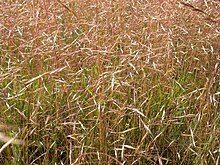Ventenata dubia
| Ventenata dubia | |
|---|---|

| |
| Scientific classification | |
| Kingdom: | |
| (unranked): | |
| (unranked): | |
| (unranked): | |
| Order: | |
| Family: | |
| Genus: | |
| Species: | V. dubia
|
| Binomial name | |
| Ventenata dubia (Leers) Coss.
| |
Ventenata dubia is a species of grass known by the common names North Africa grass and wiregrass. It is native to southern Europe, North Africa and the Middle East. It is becoming well-known in North America, where it is an introduced species and a noxious weed of cultivated and disturbed habitat. It is problematic in the Pacific Northwest, where it was first identified in Washington in 1952[1] and Idaho in 1957.[2] It was found in Utah in 1996.[3] It probably spreads when it gets mixed in with grass seed and is transported and inadvertently planted.[3]
This is an annual grass growing 15 to 70 centimeters tall with thin, branching stems that are naked and wiry. These wiry stems make the grass hard to cut.[2][3] The inflorescence is an open panicle with very slender, spreading branches bearing spikelets at their tips. The spikelet is 1 to 1.5 centimeters in length and has riblike longitudinal veins. The upper flower has a wavy awn up to 1.5 centimeters long.
References
- ^ Grass Manual Treatment
- ^ a b Prather, T. (2009). Ventenata dubia: An increasing concern to the inland northwest region. Center for Invasive Plant Mgmt.
- ^ a b c Global Invasive Species Team Weed Alert
External links
